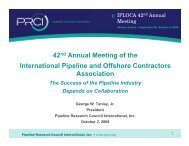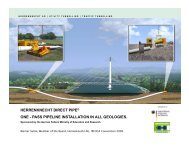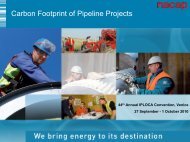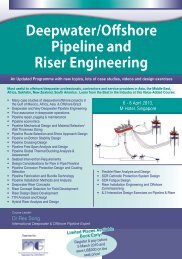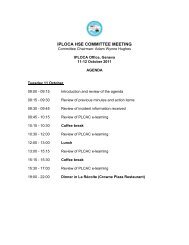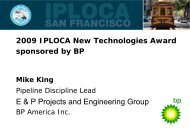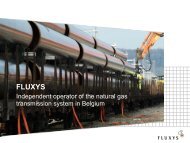EPRG-PRCI-APIA 17th JOINT TECHNICAL MEETING ON ... - Iploca
EPRG-PRCI-APIA 17th JOINT TECHNICAL MEETING ON ... - Iploca
EPRG-PRCI-APIA 17th JOINT TECHNICAL MEETING ON ... - Iploca
You also want an ePaper? Increase the reach of your titles
YUMPU automatically turns print PDFs into web optimized ePapers that Google loves.
colony and whether these coatings remain intact over the colony during cycling loading over<br />
the lifetime of the pipeline.<br />
<strong>APIA</strong> Project 1.2.16: Materials contribution to SCC susceptibility of pipelines<br />
The mechanism of crack development and growth has been the subject of extensive<br />
research and several key factors have been identified in the initiation and growth of SCC. To<br />
date these factors have been primarily environmental and operational, however no obvious<br />
unique metallurgical characteristic of line pipe manufacture or metallurgical properties has<br />
been definitively identified. There is very little understanding why two adjacent sections of<br />
pipe with coating in apparently similar condition can exhibit very different levels of damage.<br />
Extensive material property, manufacturing and operational data will be generated on<br />
apparently identical sections of adjacent line pipe cut from an operating pipeline to determine<br />
any significant differences that may explain why some lengths exhibit severe SCC and<br />
others do not<br />
<strong>EPRG</strong> Project 120: External stress corrosion cracking<br />
External SCC has been an issue for pipeline operators since the first in-service failures<br />
occurred in the US in the mid-1960s, although it has been extremely rare in Europe.<br />
<strong>EPRG</strong>’s activities have concentrated on exploring the relationship between steel type<br />
(strength and microstructure) and the likelihood of near-neutral pH SCC developing. The<br />
results showed that steels with ferrite-pearlite banded microstructures were more prone to<br />
crack initiation than a steel with a fine ferrite-bainite microstructure, and that different<br />
inclusion distributions in the steels did not have a significant influence. However, all the<br />
steels showed similar crack propagation characteristics, with a ‘dynamic’ threshold stress<br />
intensity that was considerably lower than the static threshold<br />
See also in the JTM Programme booklet:<br />
Paper 3: Overview of materials compatibility issues with fuel grade ethanol<br />
Paper 25: The practical application of <strong>APIA</strong>’s SCC research to the Moomba-Sydney<br />
pipeline<br />
Paper 26: Validation of mechanistic guidelines for the identification of SCC sites and<br />
the prediction of re-inspection intervals by comparison with field experience.



